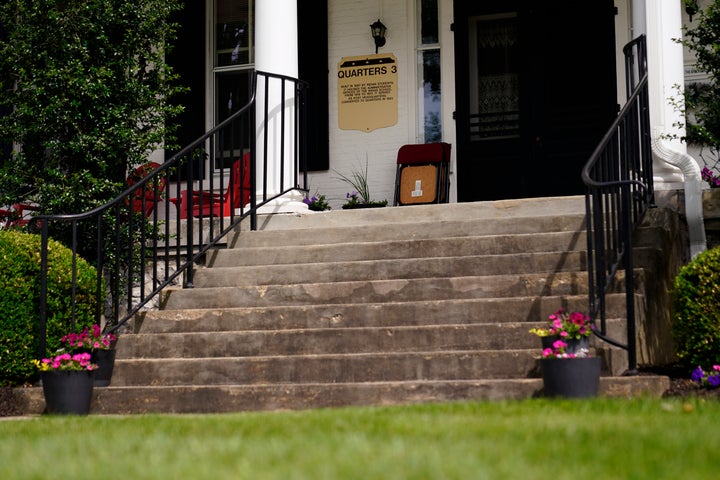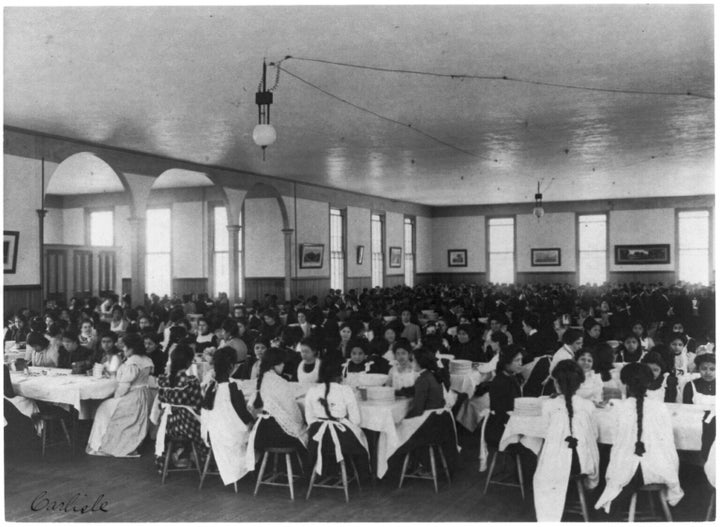On Sept. 7, 1895, two teenage boys from the Winnebago tribe entered Carlisle Indian Industrial School in Pennsylvania. The Indian agent designated by the federal government to oversee the tribe, Capt. W.H. Beck, had forced the boys, Edward Hensley and Samuel Gilbert, into five-year terms at a boarding school that the Bureau of Indian Affairs ran on Army property.
Forty-seven days later, Samuel was dead. Edward died in 1899, a year before his term would have ended. It’s not clear how either of them died, but administrators buried both boys on school grounds. No records exist to confirm whether the school sought permission from the children’s families to bury them there. It’s not clear when, or even if, school officials notified the families of Samuel’s and Edward’s deaths.

Today, Samuel’s and Edward’s graves are part of an Indian cemetery featured as a stop on tours about the history of what now serves as the Carlisle barracks. Samuel’s tombstone misspells his tribe’s name as “Winnchaga.” Edward’s reads “Winnebaloo” and lacks a date of death.
When Sunshine Thomas-Bear first tried to bring the boys’ remains home to the tribe three years ago, it looked like an open-and-shut case. Thomas-Bear acts as Winnebago’s representative of the Native American Graves Protection and Repatriation Act, or NAGPRA, a federal law enacted in 1990 that requires museums and state agencies that had pilfered tribal lands to return human remains and sacred objects. The law requires agencies to return human remains within 90 days of a formal request.
But the U.S. Army flatly refused to recognize NAGPRA, according to a lawsuit filed Wednesday, instead pushing Winnebago to use the Army’s own process and prodding them to pass a resolution through the Tribal Council before moving forward. Now Winnebago is suing the Army to force compliance with the repatriation act in a case that could have implications for other institutions that have skirted the law or slow-walked compliance.
“According to Winnebago traditional beliefs, the longer that Samuel and Edward remain at Carlisle, the more harm is done to their spirits and to Winnebago,” the complaint reads. “Winnebago believes that Samuel and Edward have been in a perpetual state of unrest since their respective burials in 1895 and 1899 and that the boys have been waiting to come home since their deaths.”
The Army declined to comment for this article, citing pending litigation.
Carlisle Indian Industrial School was the first in what would become a sprawling system of more than 400 boarding schools devised to stamp out tribal culture. The Bureau of Indian Affairs pressed tens of thousands of children like Samuel and Edward into schools far from their families to learn English, farming and trades. Students were forced to choose an English name and cut their hair, and they were barred from speaking their native languages or observing their religions. They were punished physically for breaking those rules.
The purpose of the system was to “kill the Indian, save the man,” according to the school’s founder and superintendent, Richard Henry Pratt.

Administrators tried to bury the first student to die at the Carlisle school, a boy named Amos, in a nearby government plot but disinterred him when the Department of Defense determined that only whites could be buried in the graveyard, according to the complaint. The school created its on-site burial ground in response. At least 179 Native children were buried there.
The school closed in 1918, and the Army converted the building into a hospital the following year. It later became a medical school. As the building expanded in the 1920s, the Army disinterred the graves and moved them to their current location at Carlisle Cemetery. The process appeared haphazard, the lawsuit says. The new gravestones had incorrectly spelled names and tribal affiliations, and some, like Edward’s, are missing death dates. The gravesite contains at least 14 graves of unidentified remains, according to the complaint.
Thomas-Bear first contacted Justin Buller, an Army attorney, on July 16, 2021, with a request to bring home the remains of Samuel and Edward. Buller responded that the Office of Army Cemeteries’ Disinterment and Return Process only allows the closest living relative to start a request. That would pose a challenge, Thomas-Bear said, given that both boys died at Carlisle as teenagers and never had children. Buller said the Winnebago Tribal Council could pass a resolution naming Thomas-Bear as the closest living relative.
But that wasn’t true, and neither Thomas-Bear nor the council members wanted to pass legislation that amounted to lying. Federally recognized tribes have a unique form of sovereignty, and mid-level bureaucrats do not have the authority to tell tribes what laws to pass.
“When you get to the point that you have a federal agency saying, ‘Just make it up and fill out the form,’ we have a problem,” said Greg Werkheiser of Cultural Heritage Partners, one of the attorneys representing Winnebago.
The most confusing part to Thomas-Bear was why the Army made its own rules and was not following NAGPRA. Still, she combed the census rolls, looking for a family member who could make the request.
Unable to find one, Winnebago sent a letter in October 2023 formally asking the Army to return Samuel’s and Edward’s remains under the NAGPRA process. Buller once again said the Army would use the process the Office of Army Cemeteries had devised. When Winnebago asked why the Army would not follow federal law, Buller wrote that “this matter is highly complex and cannot be addressed with simple yes or no answers.”
A month later, the Army sent the tribe a letter contending that the Carlisle graves did not amount to “collections” for the purpose of the law and that federal courts have held that NAGPRA “does not require the Army to engage in the intentional excavation or exhumation of a grave.” The letter did not note which court decisions it was referencing.
“Defendants did not cite any specific court or case, likely because they cannot: no federal court has ever held or said what Defendants assert,” the Winnebago lawsuit reads.
American museums, universities and government agencies have often delayed the return process mandated by NAGPRA and still hold the remains of more than 110,000 Native Americans, according to a series published by ProPublica and NBC News.
After reviewing their collections in search of Native American remains and sacred objects in the 1990s, as the NAGPRA demanded, some institutions described large chunks of their holdings as “culturally unidentifiable,” which critics viewed as a way to skirt the law by asserting no tribe could claim them. Others disputed modern-day tribes’ connections to centuries-old remains. Congress has also historically declined to fully fund the law’s return process, which can slow things down.
Interior Secretary Deb Haaland, a member of the Laguna Pueblo and the first Indigenous person to head the department, issued new departmental rules to clarify and streamline NAGPRA last month. These rules eliminate the “culturally unidentifiable” category for classifying remains. And they require institutions to defer to tribes and Native Hawaiian organizations when assessing cultural connections and to obtain their informed consent before exhibiting, displaying or researching tribal remains.
Though some institutions have muddied the waters with NAGPRA compliance, the Army appears to have given clear guidance: “NAGPRA applies to all Army Commands, installations, and activities and places affirmative duties on the Army for the protection, inventory, and disposition of Native American cultural items,” reads a policy guidance memo dated July 10, 2014.
But the Office of Army Cemeteries has long insisted on following its own process, a modified version of the one it uses to disinter and send home the remains of service members at the request of their families, the lawsuit says.
The Northern Arapaho Tribal Historic Preservation Office pressed repeatedly, starting in 2007, for the remains of a child buried at Carlisle, objecting to the Army’s use of the gravesite as a tourist attraction for visitors to the Carlisle Barracks. The Army initially refused, only developing a process to return the remains 10 years later, after the Northern Arapaho demanded them under NAGPRA.
Some tribes have retrieved remains through the Army’s existing process, but it can sometimes drag on for years. Some are shocked to find that the remains may not be the child they thought it would be or that individual graves contained the remains of more than one body.
“The remains they’re turning up do not match the sex and age of the person marked on the headstones,” said Jason Searle, an attorney with the Native American Rights Fund, which is also representing Winnebago. “All this confusion and mismanagement really calls for a more transparent process where tribes can be more actively involved, where they have affirmative rights that the Army can honor.”

